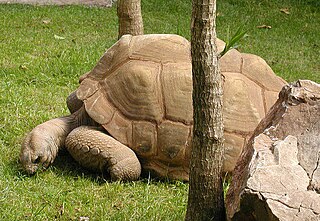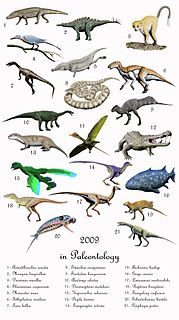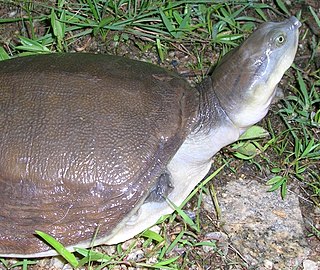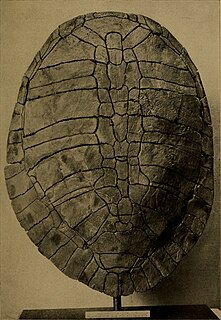Stygimys is an extinct mammal genus from the Upper Cretaceous and Paleocene of North America. It was a member of the extinct order Multituberculata within the suborder Cimolodonta, family Eucosmodontidae.

The Trionychidae are a taxonomic family of a number of turtle genera, commonly known as softshell turtles. The family was erected by Leopold Fitzinger in 1826. Softshells include some of the world's largest freshwater turtles, though many can adapt to living in highly brackish areas. Members of this family occur in Africa, Asia, and North America, with extinct species known from Australia. Most species have traditionally been included in the genus Trionyx, but the vast majority have since been moved to other genera. Among these are the North American Apalone softshells that were placed in Trionyx until 1987.

The Cryptodira are a suborder of Testudines that includes most living tortoises and turtles. Cryptodira differ from Pleurodira in that they lower their necks and pull the heads straight back into the shells, instead of folding their necks sideways along the body under the shells' marginals. They include among their species freshwater turtles, snapping turtles, tortoises, softshell turtles, and sea turtles.

Paronychodon was a theropod dinosaur genus. It is a tooth taxon, often considered dubious because of the fragmentary nature of the fossils, which include "buckets" of teeth from many disparate times and places but no other remains, and should be considered a form taxon.

Rafetus is a genus of highly endangered softshell turtles in the family Trionychidae. It is a genus of large turtles which are found in freshwater habitats in Asia.

Paleontology or palaeontology is the study of prehistoric life forms on Earth through the examination of plant and animal fossils. This includes the study of body fossils, tracks (ichnites), burrows, cast-off parts, fossilised feces (coprolites), palynomorphs and chemical residues. Because humans have encountered fossils for millennia, paleontology has a long history both before and after becoming formalized as a science. This article records significant discoveries and events related to paleontology that occurred or were published in the year 2009.

Pelodiscus is a genus of turtles in the family Trionychidae, the softshells. Based on genetic and morphological analysis there are seven valid species. They are native to Eastern Asia, ranging from the Amur region, south through China and Korea, as far south as Vietnam. Populations in Japan are thought to likely originate from historic human introductions.
Palatobaena is an extinct genus of baenid turtle. It was first named by Gaffney in 1972 and the type species is Palatobaena bairdi. It based on a fragmentary skull from the Fort Union Formation of the Bighorn Basin of Wyoming. The two other species are P. gaffneyi and P. cohen which existed in Hell Creek Formation, North Dakota during the late Cretaceous period.

Cyclanorbinae, also known commonly as the flapshell turtles, is a subfamily of softshell turtles in the family Trionychidae. The subfamily is native to Africa and Asia.

The Trionychinae are a subfamily of turtles in the family Trionychidae.

Trionyx is a genus of softshell turtles belonging to the family Trionychidae. In the past many species in the family were classified in this genus, but today T. triunguis, the African or Nile softshell turtle, is the only extant softshell still classified as Trionyx. The other species still assigned to this genus are only known from fossils. T. triunguis is a relatively large, aquatic piscivore.
Gilmoremys is an extinct genus of softshell turtle which lived during the late Cretaceous of North Dakota, Montana and Wyoming, United States.

The Adocidae are an extinct family of aquatic and omnivorous turtles. They are freshwater cryptodiran turtles and are mainly known from Cretaceous and Paleogene Asia and North America.

Adocus is an extinct genus of aquatic turtles belonging to the family Adocidae. Adocus was once considered to belong to the family Dermatemyidae.

Khunnuchelys was a genus of trionychine turtle from the Late Cretaceous of Asia. Three species are known, K. erinhotensis, the type species, K. kizylkumensis, and K. lophorhothon. K. erinhotensis is known from the Iren Dabasu Formation in China from the late Turonian until the middle Campanian. K. kizylkumensis is known from the late Turonian Bissekty Formation of Uzbekistan. The third species, described in 2013 by Danilov et al., is known from the early to middle Campanian aged Bostobe Formation of Kazakhstan.

Macrobaenidae is an extinct family of turtles, known from the Early Cretaceous to Paleogene of Laurasia. Their relationships to other turtles and whether or not they form a monophlyletic group are controversial. Initially they were intepreted as stem or crown group cryptodires, but some more recent analyses have found them to lie outside crown group Testudines. Macrobaenids can be distinguished from other testudinatans by the presence of a carotid fenestra, cruciform plastron with strap-like epiplastra, and a lack of extragulars.

Neurankylus is an extinct genus of turtles in the family Baenidae that lived between 112 and 61 million years ago in Canada and the United States. It was originally placed within the monotypic family Neurankylidae, but it has since been placed in the Neurankylinae, alongside Trinitichelys. The type species, Neurankylus eximius, was described by Lawrence Lambe in 1902. The species N. lithographicus was discovered in the Milk River Formation (Canada), alongside the holotype of the pachycephalosaurid dinosaur Acrotholus audeti.
Anatolemys is an extinct turtle genus in the family Macrobaenidae. Two species are known, both of which lived in the Late Cretaceous. Fossils were discovered in the Yalovach Formation of Tajikistan, the Kulbikin Member and Khodzhakul and Bissekty Formations of Uzbekistan and the Bostobe Formation of Kazakhstan.

Sahonachelys is an extinct genus of pelomedusoid turtle from the Late Cretaceous (Maastrichtian) Maevarano Formation of Madagascar. The genus contains a single species, Sahonachelys mailakavava.

Plastomeninae is an extinct subfamily of softshell turtles that inhabited most of North America from the Cretaceous to the Eocene. Members of this subfamily are also known as plastomenines.














